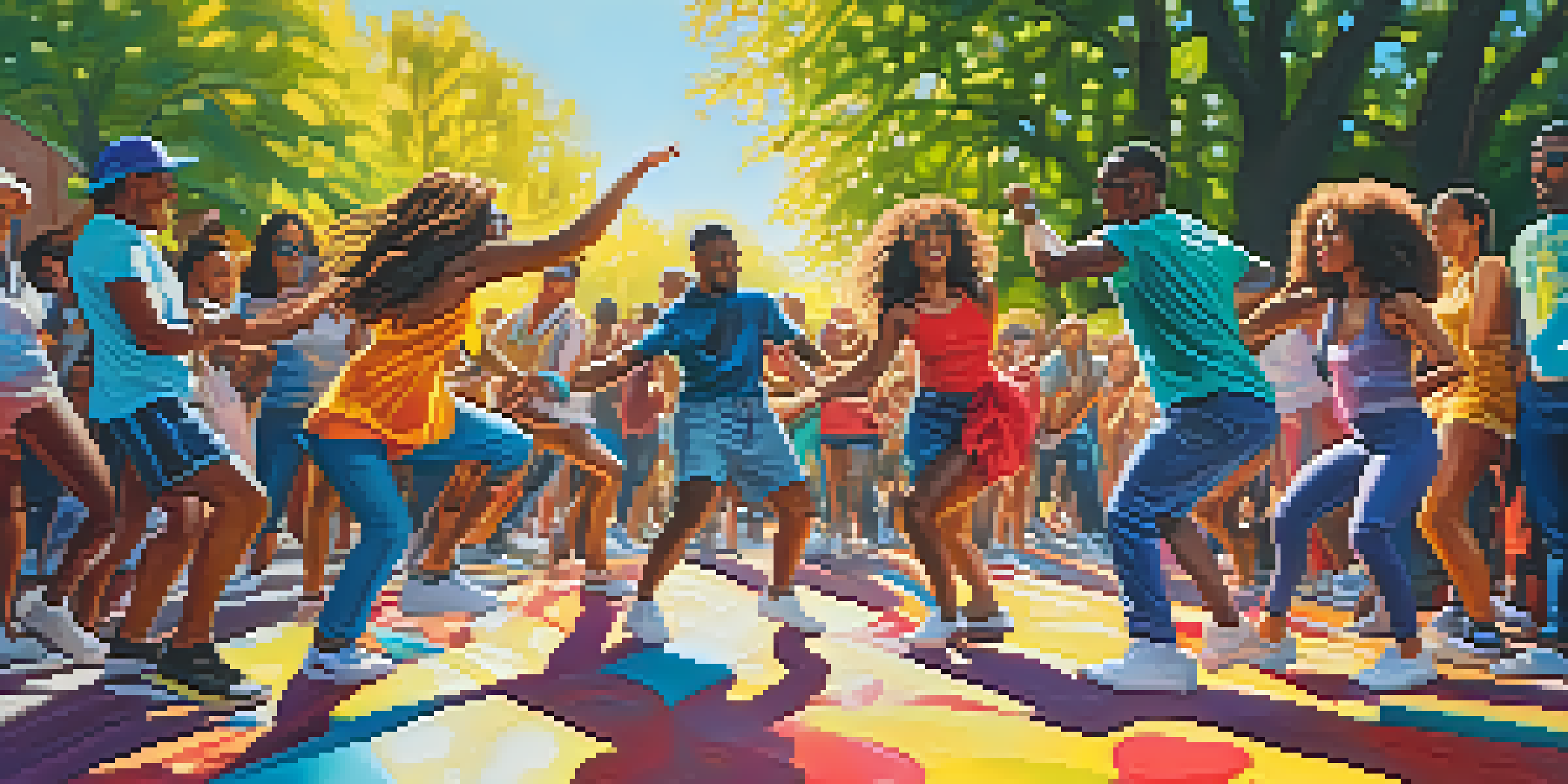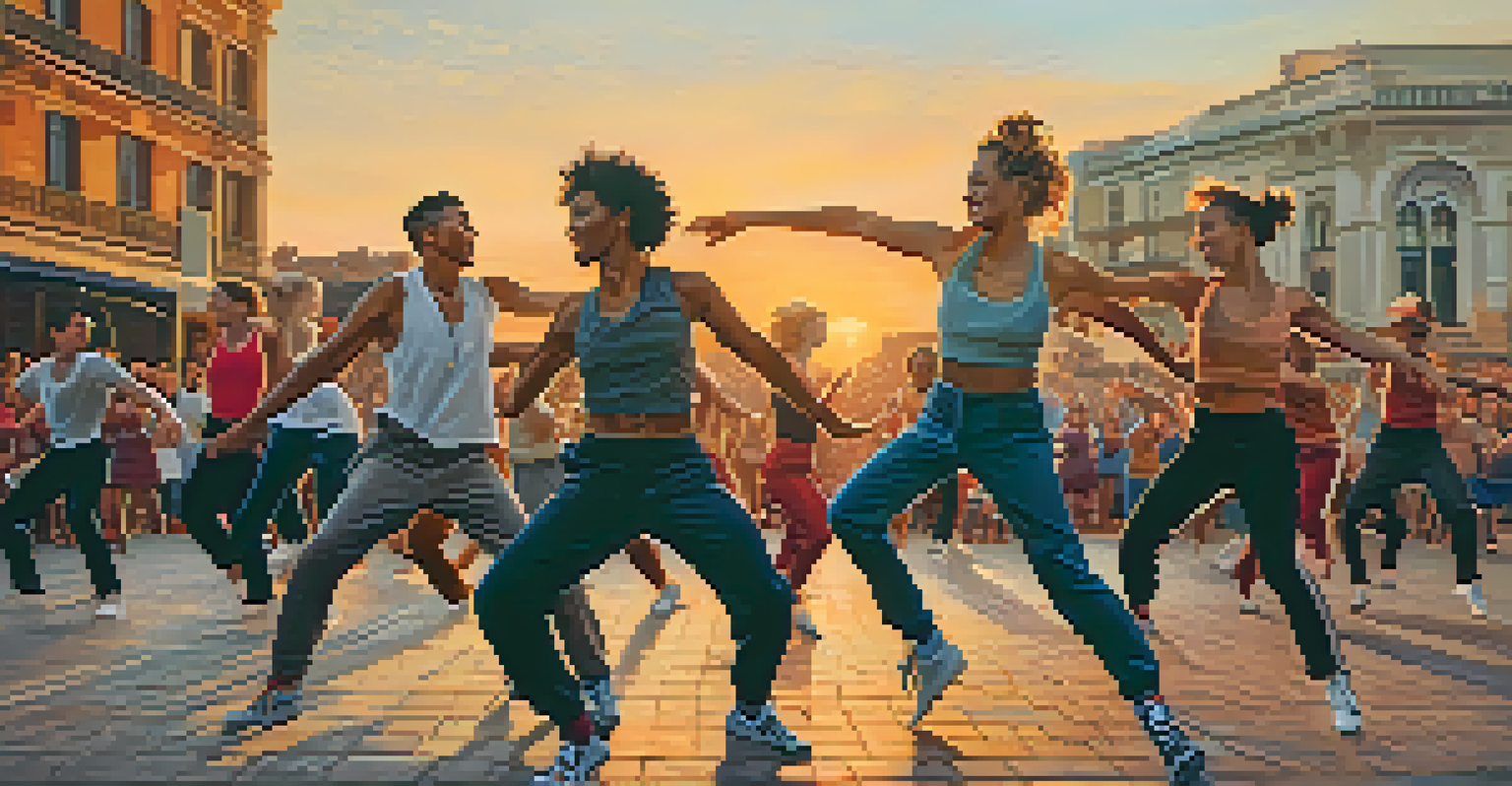The Influence of Street Dance on Global Dance Trends

The Roots of Street Dance and Its Global Spread
Street dance originated in the urban landscapes of the 1970s, particularly in New York City, where diverse communities expressed themselves through movement. Initially, it was a grassroots phenomenon, emerging from block parties and underground clubs, offering a creative outlet for youth. Over the decades, this vibrant art form has transcended borders, inspiring dancers worldwide to adopt its styles and techniques.
Dance is the hidden language of the soul.
As street dance began to gain popularity, it was showcased in various media, from music videos to television shows. Iconic performances, such as those by the Rock Steady Crew and later by shows like 'So You Think You Can Dance,' introduced audiences to the raw energy and creativity of street dance. This exposure significantly contributed to its global appeal, as people from different cultures embraced its dynamic movements.
Today, street dance is not just a style but a global movement, influencing dance competitions and dance classes everywhere. Its adaptability allows it to fuse with other genres, creating new styles that reflect the cultural tapestry of modern dance. This evolution demonstrates how street dance continues to shape and redefine dance trends around the world.
Key Styles of Street Dance and Their Influence
Street dance encompasses various styles, including breaking, locking, and popping, each with its unique flair and history. Breaking, for example, emerged from the hip-hop culture and is characterized by acrobatic moves and footwork. Meanwhile, locking and popping emphasize rhythmic movements and body control, showcasing the versatility within street dance itself.

These styles have not only influenced other dance forms but have also become integral to contemporary choreography. For instance, many commercial dance routines incorporate elements of street dance, making them more relatable and engaging for audiences. This blending of styles highlights street dance’s role in pushing the boundaries of creativity in performance.
Street Dance's Global Evolution
Originating in the 1970s, street dance has transformed into a powerful global movement that influences diverse dance styles and cultural expressions.
Moreover, the rise of dance competitions like the World Hip Hop Dance Championship has amplified the visibility of street dance styles. Dancers from different backgrounds come together to showcase their skills, facilitating cultural exchange and innovation. This competitive spirit encourages dancers to experiment, leading to the creation of hybrid styles that continue to evolve.
Street Dance in Popular Culture: A Powerful Force
Street dance has made significant inroads into popular culture, influencing music, fashion, and even social media trends. Iconic artists like Madonna and Beyoncé have incorporated street dance into their performances, making it a staple in mainstream music. This visibility has helped to validate street dance as a legitimate art form, attracting new generations of dancers.
The dance is a poem of which each movement is a word.
In addition to music, fashion trends often mirror the aesthetics of street dance, with baggy clothes, sneakers, and bold colors becoming synonymous with urban culture. These fashion choices not only enhance the performance but also allow dancers to express their individuality. This symbiotic relationship between street dance and fashion further cements its influence on global trends.
Social media platforms like TikTok and Instagram have also played a crucial role in promoting street dance. Viral dance challenges often feature street dance moves, encouraging users to participate and share their interpretations. This democratization of dance has led to an explosion of creativity, as people worldwide engage with street dance in their own unique ways.
The Role of Technology in Street Dance Evolution
Technology has profoundly impacted the evolution of street dance, from music production to video sharing. The rise of digital platforms allows dancers to create and distribute content globally, showcasing their skills to a wider audience. This accessibility provides opportunities for collaboration and learning, fostering a vibrant online dance community.
Moreover, advancements in music technology have transformed how street dance is performed. With access to diverse musical styles, dancers can experiment and integrate different rhythms into their routines. This fusion of music genres enriches the street dance experience and encourages innovation among performers.
Impact on Social Movements
Street dance serves as a platform for social expression and activism, uniting communities to address issues like inequality and injustice.
Additionally, online tutorials and classes have made learning street dance more attainable than ever. Aspiring dancers can easily access lessons from professionals, regardless of their location. This availability helps maintain the art form's relevance and encourages the next generation of dancers to explore and contribute to its evolution.
Impact of Street Dance on Social Movements
Street dance has often served as a platform for social expression and activism, reflecting the voices of marginalized communities. Through dance, individuals have addressed issues such as inequality, injustice, and cultural identity. This powerful form of expression not only raises awareness but also fosters a sense of unity among dancers and audiences alike.
For instance, dance battles and performances in public spaces can become acts of protest, drawing attention to social issues and encouraging dialogue. Events like the 'Dance for Justice' movement exemplify how street dance can mobilize communities and inspire change. These gatherings create a space for collective expression, reminding participants of the power of movement.
Furthermore, the global street dance community often rallies for causes close to its heart, using dance as a means of solidarity. Organizations and collectives have emerged to support social justice initiatives, demonstrating the art form's commitment to positive change. This intersection of dance and activism underscores the profound impact street dance can have beyond entertainment.
Street Dance Education: Fostering Future Generations
As street dance continues to influence global trends, education programs are emerging to foster its growth. Dance schools and workshops are increasingly incorporating street dance styles into their curricula, ensuring that future generations learn the history and techniques of this vibrant art form. This educational approach helps preserve the culture while encouraging creativity and individual expression.
Moreover, mentorship programs connect experienced dancers with newcomers, providing guidance and support. These initiatives promote a sense of community and encourage skill development, allowing young dancers to thrive. This emphasis on education not only nurtures talent but also strengthens the bond between generations of dancers.
Education Fosters Future Talent
Emerging education programs in street dance are vital for preserving its culture while nurturing creativity and skill among future generations.
Incorporating street dance into formal education also challenges traditional perceptions of dance. By recognizing the value of street dance alongside classical forms, institutions can create a more inclusive environment. This shift in perspective highlights the importance of diverse dance styles in the broader cultural landscape, ensuring that street dance continues to inspire and innovate.
The Future of Street Dance: Trends on the Horizon
Looking ahead, street dance is poised to continue its evolution and influence on global dance trends. As new styles emerge and existing ones adapt, we can expect to see a rich tapestry of movement that reflects contemporary culture. The blending of street dance with other genres will likely give rise to exciting collaborations and innovative performances.
Additionally, as technology advances, we may witness even more ways for dancers to connect and share their work. Virtual reality and augmented reality could create immersive dance experiences, allowing audiences to engage with performances in unprecedented ways. This technological integration promises to expand the reach and impact of street dance on a global scale.

Ultimately, the future of street dance is bright, fueled by creativity, community, and a commitment to self-expression. As it continues to inspire new generations, street dance will remain a vital force in shaping the dance landscape worldwide. The journey of street dance is far from over, and its influence will undoubtedly resonate for years to come.